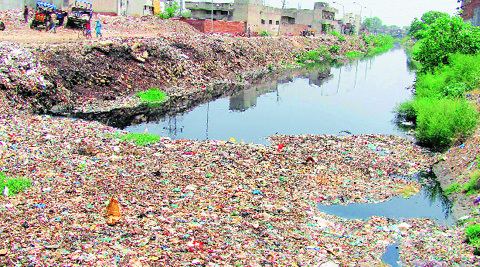 | ||
Buddha nullah in ludhiana
Buddha Nullah or Buddha Nala (Punjabi: ਬੁੱਢਾ ਨਾਲ਼ਾ) is a seasonal water stream, which runs through the Malwa region of Punjab, India, and after passing through highly populated Ludhiana district, Punjab, India, it drains into Sutlej River, a tributary of the Indus river. Today it has also become a major source of pollution in the region as well the main Sutlej river, as it get polluted after entering the highly populated and industrialized Ludhiana city, turning it into an open drain. Also, since large area in south-western Punjab solely depend on the canal water for irrigation, and water from Buddha Nullah enters various canals after Harike waterworks near Firozpur, thus affecting far-reaching areas such as Malout, Zira, upper Lambi, while the areas being fed by Sirhind feeder, are the most-affected by its pollution.
Contents
In 2006, a Ludhiana-based human rights organisation, filed a case regarding the state of the nullah in the Punjab State Human Rights Commission (PSHRC) and even invited environmentalist, Balbir Singh Seechewal, who had earlier cleaned the 164-km-long highly polluted Kali Bein rivulet with the help of his followers and without the government aid, to take the cause of cleaning up the nullah. A study conducted by Punjab Agricultural University in 2008, revealed presence of toxins and heavy metals in the food chain due to use of its water, to cultivate vegetables and other crops. This was followed by another study by the School of Public Health, Department of Community Medicine, PGIMER, Chandigarh, and the Punjab Pollution Control Board (PPCB), which also showed heptachlor, beta-endosulphan and chlorpyrifos pesticides in concentrations exceeding the maximum residue limit in samples of ground and canal water used for drinking, the pesticides were also detected in fodder, vegetables, blood, bovine and human milk samples, indicating that these have entered the food chain due to the use of agricultural run-off and irrigation of field with drain water. With increasing poisoning of the soil, the region once hailed as the home to the Green Revolution, now due to excessive use of chemical fertilizer, is being termed the "Other Bhopal", and "even credit-takers of the Revolution have begun to admit they had been wrong, now that they see wastelands and lives lost to farmer suicides in this "granary of India".
Deadly pollution in buddha nullah water
Geology
Buddha Nullah, literally, means Old rivulet or watercourse, and it runs parallel to the Satluj on its south for a fairly large section of its course in the Ludhiana district and ultimately joins the Satluj at Wajipur Kalan in the northwestern corner of the district. It floods during the rainy season, but in the dry season it can be crossed on foot at certain points. Cities of Ludhiana and Machhiwara are situated to the south of the Buddha Nala.
Pollution
The water of the stream is polluted after it enters Ludhiana City. Buddha Nullah used to be a fresh water channel with about 56 types of fish species prior to 1964. Now it has no fish because of the high level toxicity in the water. It is now an open sewer rather than a stream. Once an asset to the city, the Nullah is now a source of public nuisance and poses a serious health hazard.
The megacity has no sewage treatment plant. Untreated domestic and industrial sewerage of the city is emptied into Buddha Nullah. The nullah, in turn, empties into the mighty Sutlej flowing nearby. Hundreds of tonnes of raw sewage from Ludhiana flows into the Sutlej every day and is distributed all over the state through irrigation canals. This polluted water is in turn used for growing food crops, vegetables and fruits and is a known carrier of diseases. According to the State Department of Fisheries the pollution of the Buddha Nullah has led to the drastic reduction in the fish yield in river Sutlej.
A joint study by PGIMER and Punjab Pollution Control Board in 2008, revealed that in villages along the Nullah, calcium, magnesium, fluoride, mercury, beta-endosulphan and heptachlor were more than permissible limit (MPL) in ground and tap waters. Plus the water had high concentration of COD and BOD (chemical and biochemical oxygen demand), ammonia, phosphate, chloride, chromium, arsenic and chlorpyrifos. The ground water also contains nickel and selenium, while the tap water has high concentration of lead, nickel and cadmium. According to PPCB, the nullah water requires a sewage treatment capacity of at least 150 million imperial gallons (680,000 m3) per day for treatment while present sewage treatment plants at Jamlapur, Nalloke and Bhattian have a combined capacity of 311 MLD.
In 2010, water samples taken from the Nullah, showed heavy metal content as quite high and the presence of uranium 1½ times the reference range. For example, chromium was 50 times the reference range, aluminum and iron 20 and 60 times higher, while concentration of silver, manganese, nickel and lead was equally high. Presently, sewage treatment plants of 466 MLD (48 MLD at Jamalpur, 111 & 50 MLD at Bhattial and 152 & 105MLD at Balloke) are operational for the treatment of the sewage of Ludhiana citty.
Response
In June 2009, Ludhiana district administration imposed article 144 around the nullah, banning the throwing of garbage in it, but in the following months it was scarcely implemented, despite public outcry. In the following month, the Government of Punjab, allocated Rs. 500 million for the cleaning up of the nullah., and in August, the municipal corporation in a demolition drive, removed a large number of illegal encroachments from both sides of the nullah.
On 4 April 2011 Indian Ministry for Environment and Forests has decided to launch "In Situ Bio-Remediation Project" on Buddha Nullah in Ludhiana.
